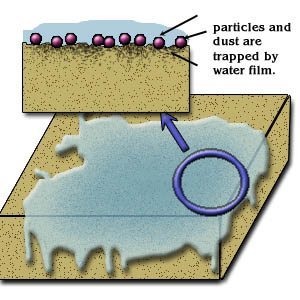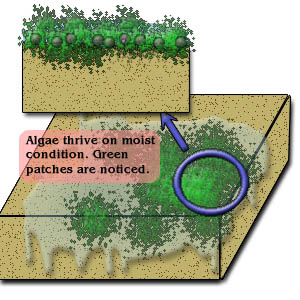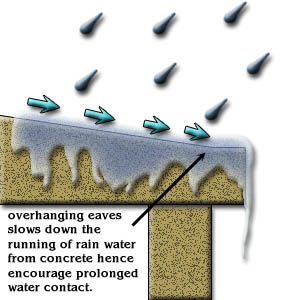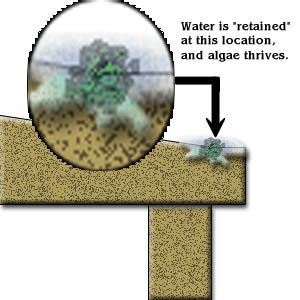Case 1
- Introduction
- Causes of Defects
- Good Practices
- Standards
- Maintenance and Diagnostics
- Remedial
- Similar Cases
- References
Cause of Defects
- Concrete as a porous material absorbs water easily.
- After rain, a thin film of moisture remains on the concrete surface. This film of water traps dirt and organic particles from atmosphere. With moisture, sunlight and dirt particles, algae thrive rapidly and form large patches of green stains on the façade [1].
- Inadequate maintenance [3]
Conditions of wall that are conducive for algae growth [1]:



- exposed to atmospheric pollution walls (Figure 1a, b and c)
- remain wet during wet seasons


- sloping or with overhanging eaves (Figure 2a and b). The rate of flow of water is slower, thus making it easier for water to seep into the subgrade of the surface, which encourage biological growth.

- wall with special design features (Figure 3). These are responsible for causing wind turbulence, which will make dust and spores to be collected at angles.
- moist and carbonated surfaces with sufficient surface deposits of dirt containing enough organic matter.
Consequences
Weeds and shrubs that grow on rooftops usually sprout out from cracks and crevices that are filled with an accumulation of soil and dust particles and other nutrients. These can be weeded out and the cracks filled. They are less prominent than those that growing in cracks in external walls, which are more exposed to view. Besides undermining the aesthetic value of the façade, such growth could well undermine the structural integrity of the building.
Although biological growth on walls may not normally be structurally damaging, they do disfigure the wall and makes treatment difficult and costly [2].
Algae Growth
Algae growth has been characterised by two (a) factors attributed to the environment (b) factors attributed to the building envelope. Environmental factors consist of climate, thermal amplitude, precipitation, hygrometry (humidity), distance from the sea and presence/absence of vegetation. Precipitation and hygrometry directly affect the availability of water on to building facades, which is widely known as one of the key requirements for algae growth. In Singapore, the high humidity and precipitation result in buildings experiencing high amounts of water contact throughout the year. The closeness of the building to the sea can also result in higher atmospheric humidity, leading to a greater chance of algae growth. Building related factors affecting algae growth are high alkalinity (e.g. fresh concrete, high in alkaline helps algae to grow), excess surface moisture, windborne transport (orientation), and rain streaks that carry the algae spores down a façade.
Left unchecked, algae will grow on surfaces to create an aesthetically subjective discolouration with various shades of green, orange, black or blue. Besides being aesthetically unpleasant, biological growth on facades may also cause deterioration and further weathering to the wall.